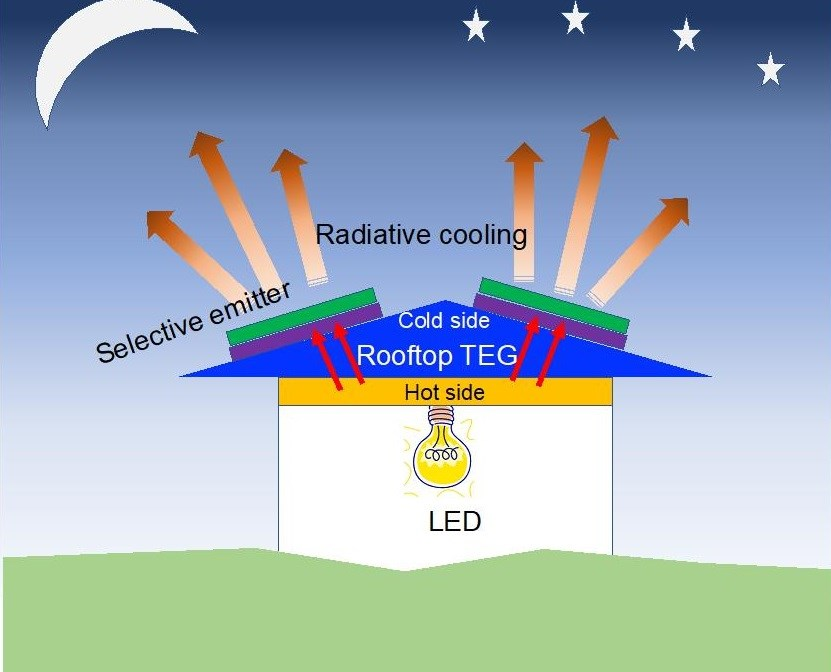Aug 14 2020
An off-grid and low-cost modular energy source designed by Stanford scientists can efficiently generate power even at night.
 Researchers have designed an off-grid, low-cost modular energy source that uses radiative cooling to efficiently produce power for lighting at night. Image Credit: Lingling Fan and Wei Li, Stanford University.
Researchers have designed an off-grid, low-cost modular energy source that uses radiative cooling to efficiently produce power for lighting at night. Image Credit: Lingling Fan and Wei Li, Stanford University.
The innovative system employs technology that is easily available in the market and could ultimately help fulfill the requirement for nighttime lighting in urban regions. It could also offer lighting in developing nations.
While solar power offers a number of advantages, its application largely relies on the distribution of solar light. But sunlight can be limited in several places and is fully unavailable at nighttime. Systems that preserve the energy generated during the daytime are generally costly, thus increasing the cost of using solar power.
Hence, to identify a less-costly option, a research team headed by Shanhui Fan from Stanford University, focused on radiative cooling. This technique produces electricity by using the temperature variation resulting from the radiant cooling effect of cold space and the heat absorbed from the surrounding atmosphere.
The team theoretically showed an improved radiative cooling method that can produce 2.2 W/m2 with a rooftop device that eliminates the need for a battery or other external source of energy. This power is approximately 120 times the proportion of energy that has been experimentally shown, and is sufficient to power modular sensors, like the ones utilized in environmental or security applications.
The study was published in Optics Express—a journal from The Optical Society (OSA).
We are working to develop high-performance, sustainable lighting generation that can provide everyone—including those in developing and rural areas—access to reliable and sustainable low cost lighting energy sources. A modular energy source could also power off-grid sensors used in a variety of applications and be used to convert waste heat from automobiles into usable power.
Lingling Fan, Study First Author, Stanford University
Maximizing Power Generation
A thermoelectric power generator is one of the most efficient methods to produce electricity using radiative cooling. Devices like these employ thermoelectric materials to produce power by changing the temperature variations between a heat source and the cool side, or radiative cooler, of the device into an electric voltage.
In the latest study, the team improved every step of the generation of thermoelectric power to increase the generation of power during nighttime from a single device that would be utilized on a rooftop.
The researchers enhanced the energy harvesting process so that more amount of heat flows inside the system from the surrounding atmosphere and integrated new thermoelectric materials that are easily available in the market to improve how well that energy is utilized by the device.
The team also estimated that a thermoelectric power generator covering 1 m2 of a rooftop can possibly achieve an optimal trade-off between thermoelectric conversion and heat loss.
One of the most important innovations was designing a selective emitter that is attached to the cool side of the device. This optimizes the radiative cooling process so that the power generator can more efficiently get rid of excessive heat.
Wei Li, Team Member, Stanford University
To demonstrate the novel method, the researchers employed computer modeling to replicate a system with true physical parameters. The models reliably simulated earlier experimental outcomes and showed that the improved system developed by the team could come close to what has been estimated as the highest efficiency using thermoelectric conversion.
Besides performing experiments, the team is also looking at the best possible designs to use the system both during the day and night, which could extend the practical use of the new system.
The study is funded by the U.S. Department of Energy under Grant No. DE-FG02-07ER46426.
Journal Reference:
Fan, L., et al. (2020) Maximal nighttime electrical power generation via optimal radiative cooling. Optics Express. doi.org/10.1364/OE.397714.